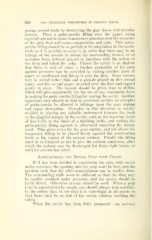Page 708 - My FlipBook
P. 708
366 THE TECHNICAIi PROCEDURES IN FILLING TEETH.
gering several teeth by destroying the gum tissue and alveolar
process. Place a gutta-percha filling over the paper, using
especial care not to make unnecessary pressure over the exposure
of the pulp that will cause compression and pain. This gutta-
percha filling should be as perfect in its adaptation to the cavity
walls as it is possible to make it, in order that there may he no
leakage of the arsenic to poison the surrounding tissues', or of
moisture from without inward to interfere with the action of
the drug and infect the pulp. Unless the cavity is so shallow
that there is lack of room, a further protection of the pulp
against pressure may be provided by cutting another piece of
paper or cardboard and fitting it over the first. Some cement
may be mixed rather thin and a globule placed on this second
paper, and the second paper inverted over the first and tapped
gently to place. The cement should be given time to stiffen,
which will give opportunity for the use of any reasonable force
in making the gutta-percha filling for sealing the cavity. Another
important care should be that in proximal cavities no overplus
of gutta-percha be allowed to infringe upon the gum septum
and cause absorption. Overplus in this direction is readily
avoided by placing any suitable instrument between the teeth
at the gingival margin of the cavity, such as the tapering shank
of hoe 8-3-6, or the blade of a finishing knife, and making the
gutta-percha filling against it, afterward removing the instru-
ment. This gives room for the gum septum, and yet allows the
temporary filling to be placed firmly against the proximating
tooth in the region of the normal contact. Finally the filling
must be so trimmed as not to give the patient annoyance, after
which the patient may be discharged for forty-eight hours, or
until the arsenic has acted.
Anesthetizing the Dental Pulp with Cocain.
If it has been decided to anesthetize the pulp with cocain
imder pressure, the opening into the pulp must be free, and the
position such that the after-manipulation can be readily done.
The surrounding walls must l)o sufficient so that the drug may
be readily confined under pressure, and the access should be
fairly direct. Otherwise arsenic should be used. When a pulp
is to be anesthetized by cocain, one should always look carefully
to the rubber dam to see that it is watertight at all points so
that there shall be no risk of the cocain solution reaching the
saliva.
When the cavity has been fully prepared — an occlusal


